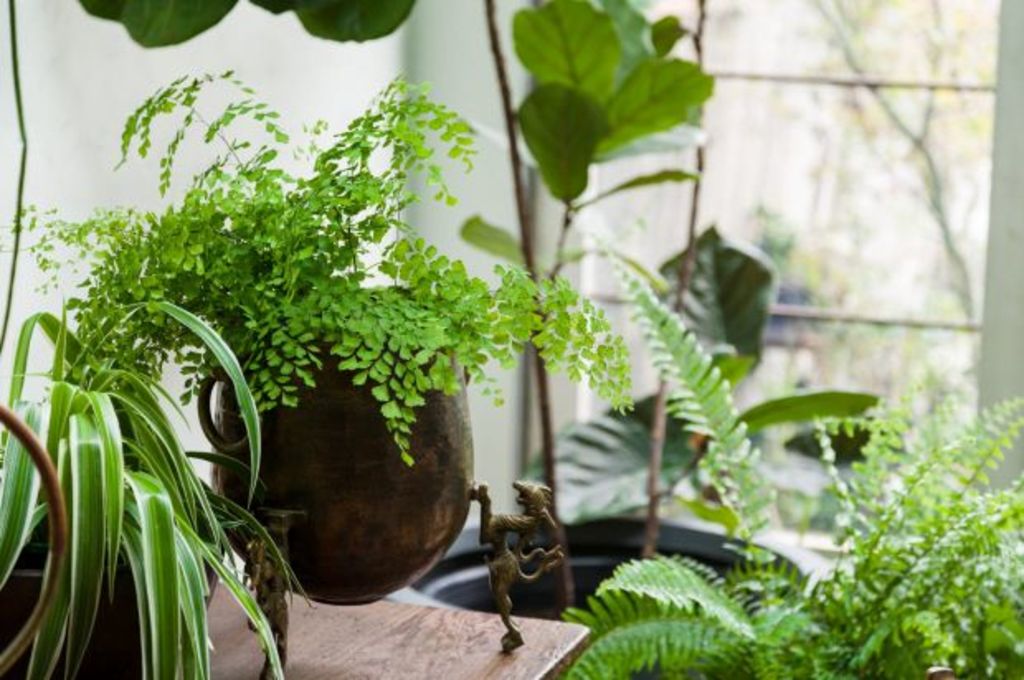Why we should all be concerned about getting more plant / life balance

As more of us live the urban life, greening up has become a vital wellbeing issue.
Think about it: from the house to the car to the office and back again, how much nature did you get today? Research shows that urbanites are clocking 90 per cent of their time indoors and, despite our love for a green smoothie, that means we’re missing out on some serious health benefits that vitamin N (that would be nature) can bring.
Luckily, we don’t need to skip around a meadow on the regular – we just need to bring the outdoors in. A report from RMIT and the University of Melbourne suggests that indoor plants can have a significant impact on how we feel, both physically and emotionally.
Adding just five humble pot plants to your living room has the potential to increase air quality by 75 per cent and mental wellbeing by 60 per cent. “Plants can make a significant difference to our wellbeing,” says Dr Dominique Hes, the lead researcher and director of the Thrive Research Hub at the University of Melbourne. “When we’re connected to nature the oldest part of the brain, the big part that controls the fight or flight response, is more relaxed. The result is that other parts of the brain function better, we are less stressed and therefore healthier.”
The wellbeing experts are on board, too. “Interacting with nature is such an important part of health and wellbeing,” says naturopath Hannah Boyd of New Leaf, who prescribes tree-watching as part of her treatments. “Plant-filled environments are restorative to our senses, help lower our stress levels, improve our mood and can even help us focus better – and that applies to everyone, from little kids to the elderly.”
If you haven’t gone near indoor plants since you killed your nana’s cactus, don’t worry – they’re easier to care for than you think, says The Planthunter‘s Georgina Reid, and they make any space look better. A little prep, however, doesn’t go astray. “Before you head off to the nursery, do a little site assessment of your space, focusing mainly on light,” she suggests. “Then look at things like heating and cooling systems – fans, air conditioners, heaters – as all these things can affect indoor plants.”
Not sure how many houseplants you need for maximum wellbeing? Download the Plant Life Balance app. Australia’s first virtual greening app rates your space and shows you how you can improve your health score by adding more plants. If your place is in need of some more greenery, the app can help you visualise it allowing you to drag and drop plants over a photo of your room so you can see just how many plants you’ll need to increase the healthy credentials of the space.
It’ll even give you some styling inspiration with seven looks within the app created in collaboration with The Planthunter for inspiration, alongside helpful tips, and plant lists to take straight to your local nursery.
Don’t worry if you live in a space that’s more dungeon than sun-drenched, you can still keep plants happy— Reid suggests the Instagram-favourite fruit salad plant (Monstera deliciosa), cast iron plant (Aspidistera elaitor) and devil’s ivy (Epipremnum aureum); “all toughies who will tolerate low light conditions.” And if you spot a succulent you fancy at a friend’s place, you can even play copycat and grow your own. “The greatest ever plant hack is propagation,” says Reid. “Just break a leaf off, throw it on a windowsill to dry out for a week, and then stick it in some potting mix and give it some water. Bam! New plant!”
If your new plants go the same way nana’s cactus did, don’t freak out – it doesn’t mean you’re a black thumb.
“Remember that they will die at some point, whether in your care or not,” says Reid. “The key is to use each death as a learning experience. Don’t get sad, get curious. Try to understand what happened to the plant to make it turn its toes up and don’t do it again! Plants are not objects. They’re living, breathing beings who change and evolve every single day, just like us. Observing them closely, and seeing how they respond to different environments, watering regimes, fertiliser, will help you to know and understand how to love them best.”
And if you want to take your plant love to the next level, you can turn your pots into a mindfulness exercise, according to yoga instructor Monique Blackwell, of Little Things Yoga.
“When trying to clear the mind and focus on something positive, I often simply turn to a plant,” she says. “I mindfully look at the depth of green, notice the way the leaves may move and if I can, try to notice the lines in the detail of the leaves. This is a mindful escape, an opportunity to be present and focus on something that makes me feel calm and within nature.”
See you at the nursery!
Top five tough indoor plants

Plants top row (left to right): Fruit salad plant, Mistletoe Cactus, Cast iron plant. Plants bottom row: Devil’s ivy, Wax flower. Photo: Domain
Nothing is unkillable, says The Plant Hunter’s Georgina Reid, but these guys come pretty close:
- Fruit salad plant (Monstera deliciosa)
- Mistletoe Cactus (Rhipsalis spp)
- Cast iron plant (Aspidistera elaitor)
- Devil’s ivy (Epipremnum aureum)
- Wax flower (Hoya australis)
We recommend
We thought you might like
States
Capital Cities
Capital Cities - Rentals
Popular Areas
Allhomes
More







